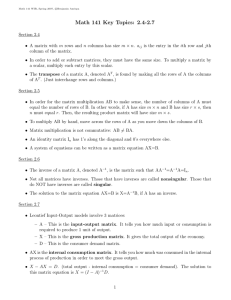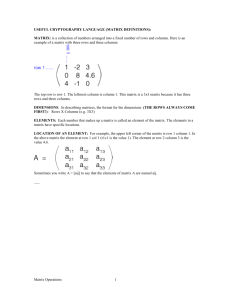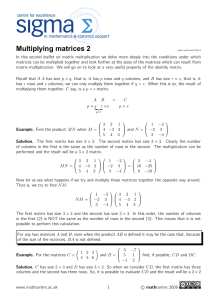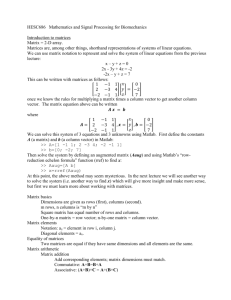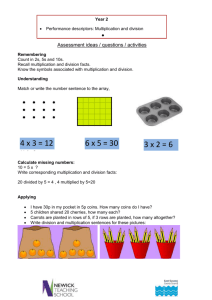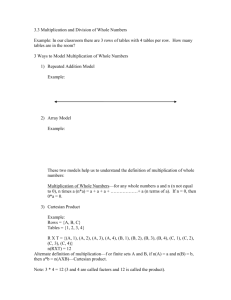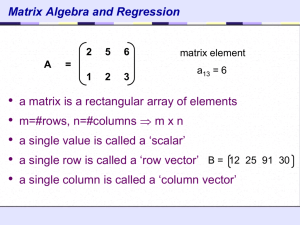Multiplying Matrices 1 (Mathcentre)
advertisement
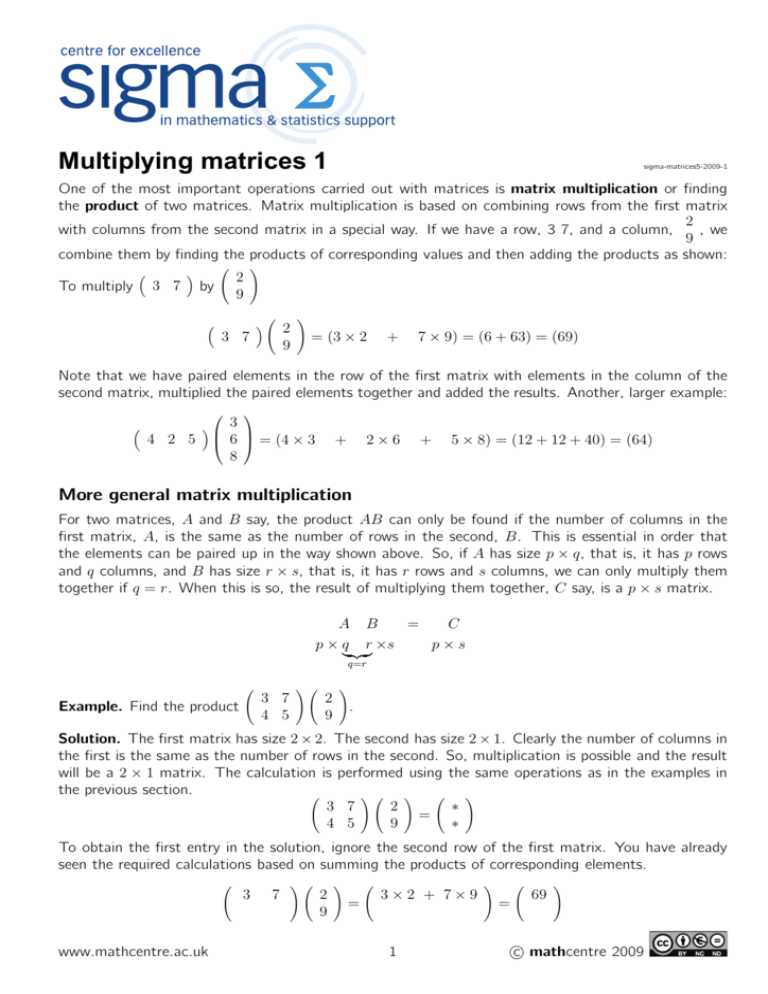
Multiplying matrices 1
sigma-matrices5-2009-1
One of the most important operations carried out with matrices is matrix multiplication or finding
the product of two matrices. Matrix multiplication is based on combining rows from the first matrix
2
with columns from the second matrix in a special way. If we have a row, 3 7, and a column,
, we
9
combine them by finding the products of corresponding values and then adding the products as shown:
To multiply
3 7
by
!
2
9
3 7
2
9
!
= (3 × 2
+
7 × 9) = (6 + 63) = (69)
Note that we have paired elements in the row of the first matrix with elements in the column of the
second matrix, multiplied the paired elements together and added the results. Another, larger example:
4 2 5
3
6 = (4 × 3
8
+
2×6
+
5 × 8) = (12 + 12 + 40) = (64)
More general matrix multiplication
For two matrices, A and B say, the product AB can only be found if the number of columns in the
first matrix, A, is the same as the number of rows in the second, B. This is essential in order that
the elements can be paired up in the way shown above. So, if A has size p × q, that is, it has p rows
and q columns, and B has size r × s, that is, it has r rows and s columns, we can only multiply them
together if q = r. When this is so, the result of multiplying them together, C say, is a p × s matrix.
A
p×q
B
=
C
r ×s
p×s
| {z }
q=r
3 7
4 5
Example. Find the product
!
2
9
!
.
Solution. The first matrix has size 2 × 2. The second has size 2 × 1. Clearly the number of columns in
the first is the same as the number of rows in the second. So, multiplication is possible and the result
will be a 2 × 1 matrix. The calculation is performed using the same operations as in the examples in
the previous section.
!
!
!
3 7
2
∗
=
4 5
9
∗
To obtain the first entry in the solution, ignore the second row of the first matrix. You have already
seen the required calculations based on summing the products of corresponding elements.
3
www.mathcentre.ac.uk
7
!
2
9
!
=
3×2 + 7×9
1
!
=
69
!
c mathcentre 2009
To obtain the second entry in the solution, ignore the first row of the first matrix.
4
!
5
2
9
!
=
4×2 + 5×9
!
=
53
!
Putting it all together
!
3 7
4 5
2
9
!
3×2 + 7×9
4×2 + 5×9
=
!
2 4
5 3
Example. Find the product AB when A =
!
=
69
53
3 6
−1 9
and B =
!
!
.
Solution. The first matrix has size 2 × 2. The second matrix has size 2 × 2. Clearly the number
of columns in the first is the same as the number of rows in the second. The multiplication can be
performed and the result will be a 2 × 2 matrix.
AB =
2 4
5 3
!
3 6
−1 9
!
2
5
!
Example. Find, if possible,
=
2 × 3 + 4 × (−1)
5 × 3 + 3 × (−1)
3 6
−1 9
!
2×6+4×9
5×6+3×9
!
=
2 48
12 57
!
.
Solution. The first matrix has size 2 × 1. The second matrix has size 2 × 2. This time, the number of
columns in the first (1) is not the same as the number of rows in the second (2). It is not possible to
multiply these matrices together.
Example. Find
3 2
1 4
!
x
y
!
.
Solution. The first matrix has size 2 × 2. The second matrix has size 2 × 1. Clearly the number
of columns in the first is the same as the number of rows in the second. The multiplication can be
performed and the result will be a 2 × 1 matrix.
3 2
1 4
!
x
y
!
=
3x + 2y
x + 4y
!
There are more examples of matrix multiplication in the next leaflet in this series.
Note that a video tutorial covering the content of this leaflet is available from sigma.
www.mathcentre.ac.uk
2
c mathcentre 2009
